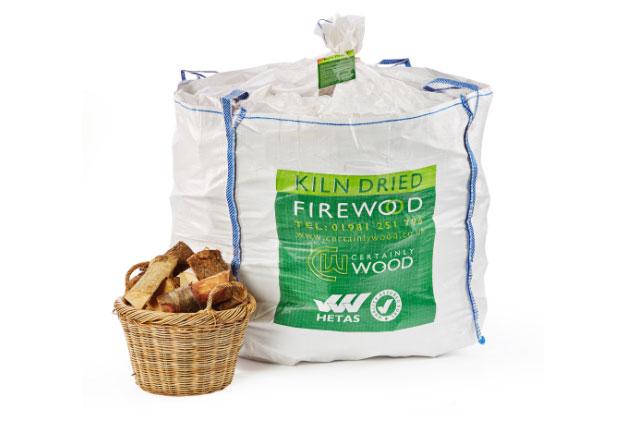Flamers Firelighters
Firewood quality in Herefordshire is now more important than ever as more and more people install wood burning stoves and there is a greater focus on particulate emissions. But what is, best quality firewood and how do you get the best firewood burn quality.
Firewood Quality
Quite simply it’s all about moisture content. The drier the wood the better it burns. Freshly cut wood will contain about 60-70% moisture content depending on species but to achieve the best firewood burn quality, the wood must be dried to below 20% moisture content, but it’s almost a case of the drier the better. This ensures a clean burn with maximum heat output. Most importantly for a guarantee of quality, only buy wood that approved under the Woodsure Ready to Burn scheme. In 2021 it becomes law that any volume sold below 2m3 must be Ready to Burn approved.
Seasoning Firewood
It takes a long time to season wood naturally – up to three years. Be careful when buying your logs and make sure you get a full understanding of the quality you are buying. Many suppliers will claim the wood has been ‘down’ for two years and therefore dry and nowadays many suppliers will say their logs are kiln dried. That does not mean it’s dry. It is not about the time the tree has been cut down, but more about how the wood is stored. It must be sawn into log size, split and stored under cover for meaningful seasoning to take place. The best thing to do is check the moisture on delivery with a moisture meter.
Hardwood Firewood versus Softwood Firewood
Many people say you should not burn softwood as it smokes, tends to spit, burns too quickly and can tar up the chimney. Once again if you buy kiln dried logs or have the best way to season firewood in a dry and airy store and can dry to a moisture content below 20%, then you will not have any of the above problems. These only arise when the wood is not sufficiently dry.
Softwood (Spruce, Pine, Larch, Douglas Fir etc) will have the same energy content per kilogram as hardwoods (Oak, Ash, Beech, etc), however being far less dense, you will need up to twice as many logs (or volume) to achieve the same heat output.
We only use British hardwood logs as we presently regard them as providing the best value for money.
Firewood Quality Chart
The following firewood chart shows the typical species that we use for our British hardwood firewood, although we have added at the end a photo of Softwood Pine just to show the difference visually. The aim of this poster is to help you identify the most common types of firewood that you may have had delivered. It will help you to better understand different species and the different way they each burn. Although all hardwoods, they will burn with slightly different characteristics.
- Oak Firewood
- Is very dense and takes a long time to dry to the core, but makes a great firewood with a long burn and good heat output. At times, this wood will require a little more draft/air from the stove setting to maintain a good burn, however once a good base is established, then the burn time will be very long.
- Ash Firewood
- Many people say this is the ‘king of firewoods’ and claim it can be burnt wet. Yes, it can dry quite quickly but still don’t burn it green. The fundamentals of firewood burn quality still apply and the moisture content must be below 20%. Ash wood gives a nice bright flame and burns very nicely albeit slightly faster than oak
- Beech Firewood
- Like oak, this is a very dense species and needs a lot of drying, but once dry burns with a nice bright yellow flame and for a long time. It also has a smooth bark so nice to handle.
- Alder Firewood
- Can be quite a dense wood and characteristically has quite a distinctive orangey flesh colour. Once dry it can actually be quite light in weight and will therefore burn quite quickly. Alder is more commonly from Eastern Europe. It is highly unlikely for you to be able to buy 100% alder sourced from the UK.
- Birch Firewood
- One of the most attractive of logs due to its silvery, flakey bark. Burns with a nice bright flame, but will burn quite quickly. As with Alder any supply of 100% Birch will almost certainly be from Eastern Europe and not British.
It is essential that you use dry firewood in your stove or oven. Manufacturers often recommend a maximum of 20% moisture content, but up to 25% moisture content is what the HETAS quality standard recommends.
This quality will ensure a clean burn with no blackening of the stove glass or build-up of soot or tar in the chimney or flue. It also means that in an efficient stove, you will actually use far less firewood, so more cost effective.
Our kiln dried logs are ‘Ready to burn’ so all you need to do is just ensure they are stored in a cool dry place, either in a log store or garage.
When burning firewood logs on an open appliance, it’s impossible to control the air flow. Because of this, very dry firewood can sometimes burn too quickly BUT you still want to get good heat output and avoid sooting up chimneys etc.
The best solution for this is to burn kiln dried logs that are ‘chunkier’ in diameter so that there’s more log to burn through and the moisture content in the centre of the log is naturally a bit higher.
Never be tempted to go for wet firewood – Yes, they will burn slower, but you won’t get the heat output and you will actually end up using up to twice as much firewood to generate the same heat AND you will get the soot and tar build up in your chimney.
Nearly all our logs are cut to a length of 25cm (+/- 10%) and after consulting with the majority of UK stove manufacturers we know these will fit 99.9% of UK stoves.
The diameter of our standard logs are 5-15cm measured at the widest point of the log. This provides smaller logs to build a good base to the fire and larger ones for a longer burn.
We also provide logs with a length of 35cm and 50cm for larger fires or stoves. As they are longer logs, they are also slightly bigger diameter than the 25cm logs.
Bulk bags are ‘loose-filled’ i.e. dropped into the bag from a conveyor which also acts a grading system at which point final quality inspection is made. The logs are therefore not stacked in the bag. We know that the volume is correct as we check the volume in a metal cage measuring 1m x 1m x 1.2m or 1.6m tall. Fill these to the top and we confirm the volume is correct.
Probably the biggest consideration when you have a fire, whether it be an open fire, wood burning stove, pizza oven of even a chimenea or firepit is how much firewood do you need each year.
How much firewood do I need?
Depends on lots of factors such as the size of your stove, house size, insulation, how often you use the stove etc. If you are using a single woodburning stove just evenings and weekends from say October to April, you will need approx. 3-4 m3 of kiln dried firewood. Remember though that you may well be using more and more each summer in your firepit or pizza oven!
What is the best way to store firewood?
Fundamentally make sure the storage area is not only close to the house and easy to take indoors, but most importantly make sure it is convenient for delivery vehicles to deliver the logs right to the front of the store so easy to stack the logs away. You will be surprised how many people do not consider the delivery point!
The store needs to be dry making sure no wet weather can get to the logs. The firewood needs to be stacked off the ground to avoid damp coming up through the pile. A pallet provides a really good base on which to stack logs. Make sure that all sides of the store are slatted to allow maximum airflow throughout the stack of logs. Logs are best stacked neatly to allow good airflow.
The store needs a good roof. Putting a sheet over the stack is certainly not ideal as it restricts airflow across the top of the stack and in warmer weather could lead to sweating and mould growth.
In the same way as you always need air around the logs when burning, so lots of gaps for the air to travel round, the same principle applies to log storage – plenty of gaps for airflow. Have a look at our purpose built log store.
When is the best time to buy firewood?
Late summer is the best time to buy. Not only are you likely to get the driest wood from your supplier having had the summer months to season, it’s a much easier to make delivery and fill your store when its drier and the days are longer. It’s much more pleasant to stack your logs away in the evening over a glass or wine or beer, than flogging away in the dark evenings when it’s snowing or tipping with rain.
You will also find that many suppliers offer better prices in the summer as they are keen to move stocks. During July and August we always offer our best deals so get stocked up in time.
How long do I need to season logs?
As a general rule logs will take two to three years to season, but will depend on species. The denser the species e.g. oak and apple will take up to three years to dry even when the wood is cut into log lengths (av 25cm) and split. However Ash could be as quick at 6-12 months and softwood even quicker. To be honest, it is far less hassle to buy Ready to Burn kiln dried logs as this provides a guarantee of quality.
Even though you are going to be using high quality kiln dried logs which provides a clean burn, you should still ensure your flue or chimney is swept a minimum of once a year and we recommend you use an approved chimney sweep. Visit:
http://nacs.org.uk/
http://www.guildofmasterchimneysweeps.co.uk/index.php
https://www.burnright.co.uk/
There are ways of telling how dry your firewood is such as knocking 2 logs together and getting a nice hollow sound, rather than a dull thud, or observing how many cracks are appearing in the log end. Well cracked will normally suggest, well dried. Weight is also a factor as the wetter the log, the heavier it will be, but one real characteristic of our kiln dried logs is the lovely sweet aroma of the logs.
However, the really best way to check the moisture content is by using a moisture meter. This will give you a pretty good guide as the actual reading of the firewood, both inside and out. Check inside by splitting a log open. Just be aware however that moisture meters are not always 100% accurate, particularly the very cheap ones. Also, useful to note, with kiln dried logs, the outside of the log will measure lower than the inside, but the average across the log should be below 20%.









